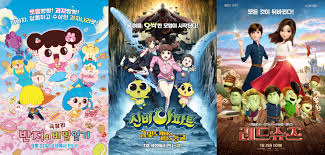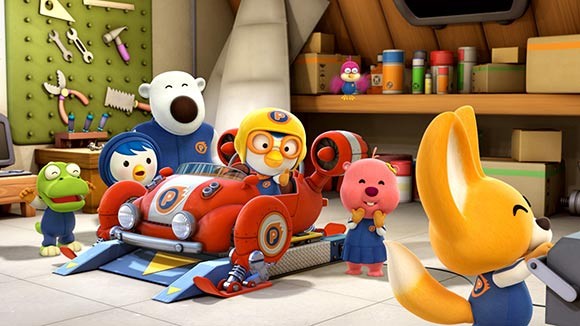
Since the beginning of the 2010’s , Korean pop stars have slowly built up a brand and an image that as of 2021 has penetrated some of the most safely guarded musical vestiges. K-pop’s meteoric rise has changed the game for South Korea, and its economic soft power is now among the largest in the world, rivaling that of its regional rival Japan.
This has of course led the South Korean government to expand from K-pop to promote other “K-industries”, K-dramas to K-food and even the slightly silly K-policing. The South Korean government has really decided to strike while the iron is hot. Though many industries have been left sitting on the shelf, not getting the recognition they deserve, especially the Korean animation industry.
If you are familiar with cartoons, or grew up watching cartoons in the 90’s and 00’s, you’ve probably watched a cartoon that was animated in South Korea. Some of the most prominent cartoons of the modern age were animated in South Korea, such as The Simpsons, Futurama, King of the hill, Family guy, and even Bob’s Burgers were all animated in South Korea.
This had led to South Korea being one of the premier locations for animation in the world, and beating Japan when it comes to non-domestic production.
Often though the animation sector has been sidelined in favour of music and other cultural productions such as movies and TV shows. While both these avenues were primarily targeted towards a domestic market, they eventually went global and attracted a sizable audience. This is not too dissimilar to Japan, whose domestic animated productions have been converted to a global audience since the 1980’s, in part due to the low cost in dubbing vs creating a new IP.
While Japan has had success in bringing domestic animation to a global audience, Korea has not readily attempted such an endeavor, instead relying on animating American productions. This has led to a sort of drought in domestic IP’s in which animation studios can produce content.

Attempts have been made though since the 80’s. With Robot Taekwon being the most famous domestically, and with some minor success in the last decade with Pororo, Turning Mecard and Shinbi Apartment.
While These shows have been successful domestically, all have failed to really capture a captive audience internationally. From my perspective there are a few key factors to this.
First is the audience target. Korean animation studios that produce content for a domestic audience target almost exclusively a very young audience, usually in the 5-12 age group. This means that even if said IP’s were to be adapted for an international audience, they have an audience that is rarely captivated long enough to ensure long term profitability (this is true for any IP’s targeting children, they really are picky consumers).
This continues to be true, with last year the Seoul Animation Center promoting content at the Singapore Asia Television Forum that is geared towards the infant to elementary school student age groups. Although those are a lucrative market, they failed to show much content for the most lucrative market of all, which is the 19-39 age group. If Korean animation wants to really break the international barrier, promoting content that appeals to a mature age group would be a good first step. Domestic content for an adult audience does exist, it's just so rare and often receives little promotion even domestically.
Second is the economic risk involved. Korean Animation studios, at least the largest ones with the best chance of producing an internationally successful IP, simply don’t want to take the risk of going it on their own. These animation studios rely on contracts from American productions to remain profitable, and taking the risk of foregoing some animation contracts, and the risk involved in trying to find a distributor and the low chance of success of actually hitting it big is simply too much to bear for most studios.
Third is the talent pool. Korea has amazing animators and has some of the most high-tech tools for streamlining the animation process, but Korea does not have an abundance of writing talent to go around. Those who do have writing talent often move abroad, or focus their efforts on their own projects such as webtoons and video games.
Korea has a 50 million person population, and while animators may be plenty, arguably writing is most important when it comes to an animation's success. Just because the animation looks beautiful, doesn’t mean it’ll be successful.
While all these things are true, Korea is poised for an animation revival. With 2016’s ”Seoul station” receiving positive reviews, this had led to renewed interest in developing animated geared towards an older audience. Both “The Shaman Sorceress” and “Beauty Water” receiving international attention has encouraged studios to look at producing their own homegrown content.
The global animation market is a near 260 Billion dollar industry, and major market players such as Disney and Dreamworks have mostly geared their films and shows to be family friendly, this has allowed Japanese studios to pick up the slack. While Japan has capitalized on this market, they certainly aren’t immune to competition and Korea is one of the few countries that can actually pose a threat to Japanese dominance in the animation industry.
So what needs to be done? There is quite a lot that could and should be done, but would take both political and economic willpower. With animation that is geared towards more of an adult audience, it would take a great shift from the government's current methods of promoting children’s animations. The Korean government has always promoted more family friendly parts of Korean pop culture, they flood the airwaves with BTS and Pengsu, and ignore the more adult oriented parts of Korean pop culture.
Now this isn’t to say that Korean animation can’t thrive, in fact I feel its success is inevitable. Korea is now a pop culture soft-power, and animation is one of the few mediums that Korea hasn’t taken by storm. I do personally feel that if the Korean animation industry were to take the global market seriously, they could easily carve themselves out a chunk of the animation industry.
Nicely done. I am learning the Korean language and I've always wanted to be an animator, so you hit 2 interests...I have friends who are translators from Japanese to English for anime. They're really good at what they do. I didn't know that Korean animators did the shows you pointed out. It's amazing how technology has made us have a world economy! Thank you for your opinion on this!
Honestly it has always surprised me how little recognition Korea gets for its animation industry. probably 75% of American cartoons have been animated in Korea since the 90's.